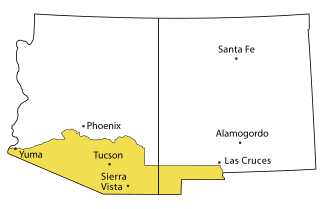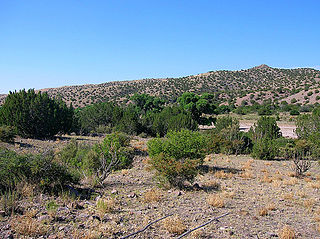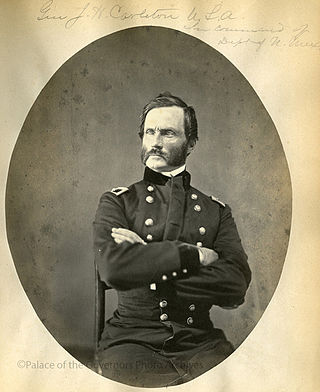
Arizona Territory, colloquially referred to as Confederate Arizona, was an organized incorporated territory of the Confederate States that existed from August 1, 1861, to May 26, 1865, when the Confederate States Army Trans-Mississippi Department, commanded by General Edmund Kirby Smith, surrendered at Shreveport, Louisiana. However, after the Battle of Glorieta Pass, the Confederates had to retreat from the territory, and by July 1862, effective Confederate control of the territory had ended. Delegates to the secession convention had voted in March 1861 to secede from the New Mexico Territory and the Union, and seek to join the Confederacy. It consisted of the portion of the New Mexico Territory south of the 34th parallel, including parts of the modern states of New Mexico and Arizona. The capital was Mesilla, along the southern border. The breakaway region overlapped Arizona Territory, established by the Union government in February 1863.

The Apache Wars were a series of armed conflicts between the United States Army and various Apache tribal confederations fought in the southwest between 1849 and 1886, though minor hostilities continued until as late as 1924. After the Mexican–American War in 1846, the United States inherited conflicted territory from Mexico which was the home of both settlers and Apache tribes. Conflicts continued as new United States citizens came into traditional Apache lands to raise livestock and crops and to mine minerals.

John R. Baylor was a US Indian agent, publisher and editor, politician, and a senior officer of the Confederate States Army. After being dismissed as Indian agent, he became one of the founding editors of The White Man, a newspaper in North Texas, and a strong critic of Governor Sam Houston.

The First Battle of Mesilla, was fought on July 25, 1861 at Mesilla in New Mexico Territory, in present-day Doña Ana County, New Mexico.
Fort Fillmore, located at 32°13′30″N 106°42′52″W, was a United States military fortification established by Colonel Edwin Vose Sumner in September 1851 near Mesilla in what is now New Mexico, primarily for the purpose of protecting settlers and traders traveling to California. Early frontier migrants were under constant threat from attack by local Native Americans, and a network of forts was eventually created by the U.S. government to protect and encourage westward expansion. Fort Fillmore was intended to protect a corridor plagued by hostile Apaches, where several migration routes converged between El Paso and Tucson to take advantage of Apache Pass.

The New Mexico Territory, comprising what are today the U.S. states of New Mexico and Arizona, as well as the southern portion of Nevada, played a small but significant role in the trans-Mississippi theater of the American Civil War. Despite its remoteness from the major battlefields of the east, and its being part of the sparsely populated and largely undeveloped American frontier, both Confederate and Union governments claimed ownership over the territory, and several important battles and military operations took place in the region. Roughly 7,000-8,000 troops from the New Mexico Territory served the Union, more than any other western state or territory.

Fort Stanton was a United States Army fort near Lincoln, New Mexico.

Prior to the adoption of its name for a U.S. state, Arizona was traditionally defined as the region south of the Gila River to the present-day Mexican border, and between the Colorado River and the Rio Grande. It encompasses present-day Southern Arizona and the New Mexico Bootheel plus adjacent parts of Southwestern New Mexico. This area was transferred from Mexico to the United States in the Gadsden Purchase of 1853. Mining and ranching were the primary occupations of traditional Arizona's inhabitants, though growing citrus fruits had long been occurring in Tucson.
The Battle of Cookes Canyon was a military engagement fought between settlers from Confederate Arizona and Chiricahua Apaches in August 1861. It occurred about 40 miles (64 km) northwest of Mesilla, in Cookes Canyon. The exact date of the battle is unknown. The battle occurred in the larger context of both the Apache Wars and the American Civil War.
The Battle of the Florida Mountains was an action of the Apache Wars. Forces involved were Chiricahua Apache warriors and mounted Confederate States militia. The battle occurred in a pass of the Florida Mountains within Confederate Arizona, now southwestern New Mexico. The engagement occurred sometime around the middle of August 1861.

The siege of Tubac was a siege during the Apache Wars between settlers and militia of Confederate Arizona and the Chiricahua Apaches. The battle took place at Tubac in present-day southern Arizona. The actual dates of this engagement have been lost to time.

The Battle of Canada Alamosa as it was known to the Union Army, or Alamosa as it was known to the Confederates, was a skirmish of the American Civil War on the late evening of September 24 and the morning of September 25, 1861. It was one of several small battles that occurred in Confederate Arizona near the border with Union held New Mexico Territory, this one being the largest.

The Gallinas massacre or the Gallinas Mountains massacre was an engagement of the Apache Wars on September 2, 1861, between a war party of Mescalero Apache warriors and four Confederate soldiers in the Gallinas Mountains of what is now Lincoln County, New Mexico. The incident occurred early in the American Civil War, at a time when the area was claimed by the Confederate States of America as part of Confederate Arizona and military control of the territory had not yet been decisively established by either Union or Confederate forces.
The Battle of Pinos Altos was a military action of the Apache Wars. It was fought on September 27, 1861, between settlers of Pinos Altos mining town, the Confederate Arizona Guards, and Apache warriors. The town is located about seven miles north of the present day Silver City, New Mexico.
The Company A, Arizona Rangers was a cavalry formation of the Confederate States Army during the American Civil War.
The Department of New Mexico was a department of the United States Army during the mid-19th century. It was created as the 9th Department, a geographical department, in 1848 following the successful conclusion of the Mexican–American War, and renamed Department of New Mexico in 1853. It had to contend with an invading Confederate force during the New Mexico Campaign of the American Civil War from mid-1861 to early 1862, then with Apache tribes during the remainder of the conflict. It was merged into the Department of California after the end of the war as the District of New Mexico.

Presidio San Agustín del Tucsón was a presidio located within Tucson, Arizona, United States. The original fortress was built by Spanish soldiers during the 18th century and was the founding structure of what became the city of Tucson. After the American arrival in 1846, the original walls were dismantled, with the last section torn down in 1918. A reconstruction of the northeast corner of the fort was completed in 2007 following an archaeological excavation that located the fort's northeast tower.

James Henry Carleton was an officer in the US Army and a Union general during the American Civil War. Carleton is best known as an Indian fighter in the Southwestern United States.

Dragoon Springs is an historic site in what is now Cochise County, Arizona, at an elevation of 4,925 feet (1,501 m). The name comes from a nearby natural spring, Dragoon Spring, to the south in the Dragoon Mountains at 5,148 feet (1,569 m). The name originates from the 3rd U.S. Cavalry Dragoons who battled the Chiricahua, including Cochise, during the Apache Wars. The Dragoons established posts around 1856 after the Gadsden Purchase made the area a U.S. territory.

Placitas, also known as La Placita and Las Placitas del Rio Bonito, in Lincoln County, New Mexico is a now abandoned village along the frontier between the New Mexico Territory and Confederate Arizona that was the site of the Battle of Placito, between Apache and native New Mexicans aided by Confederate soldiers from Fort Stanton, ten miles away to the north. The village was originally called La Placita del Rio Bonito, Placitas is now known as Lincoln. The village has historical ties to Billy the Kid.














